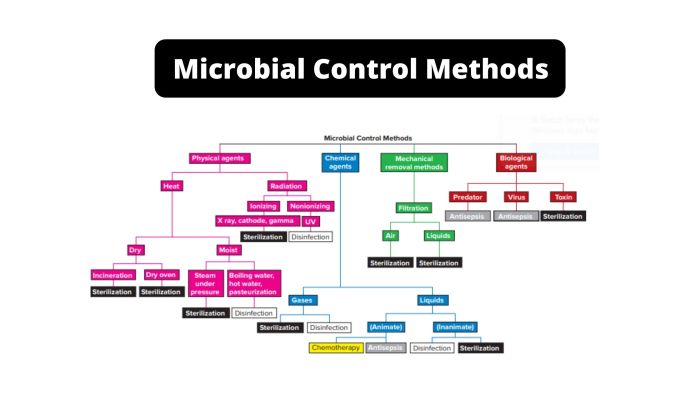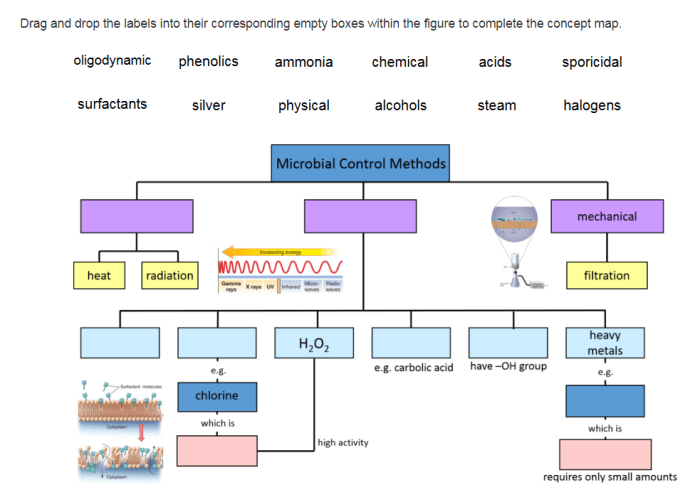Microbial control methods that kill ______ are able to sterilize. – Microbial control methods that kill microbes are essential for ensuring public health and safety. Sterilization techniques, which completely eliminate all microbial life, play a crucial role in various industries, including healthcare, food processing, and manufacturing.
This article explores the different microbial control methods, their advantages and disadvantages, and the factors affecting their effectiveness. It also discusses the applications of these methods in preventing and controlling infections, as well as emerging microbial control technologies.
Microbial Control Methods that Kill Microbes

Microbial control methods are techniques used to kill or inhibit the growth of microorganisms, such as bacteria, viruses, and fungi. These methods are essential for preventing and controlling infections, ensuring public health, and maintaining a clean and safe environment.
Physical Methods
- Heat:Heat can be used to kill microbes by denaturing their proteins and disrupting their cellular structures. Examples include boiling water, steam sterilization, and pasteurization.
- Radiation:Ultraviolet (UV) radiation can damage microbial DNA and RNA, preventing their replication and growth. Ionizing radiation, such as gamma rays, is even more effective at killing microbes.
- Filtration:Filters can be used to remove microbes from liquids or gases by physically trapping them. This method is commonly used to sterilize water and air.
Chemical Methods, Microbial control methods that kill ______ are able to sterilize.
- Disinfectants:Disinfectants are chemicals that kill or inhibit the growth of microbes on surfaces or objects. Examples include bleach, hydrogen peroxide, and alcohol.
- Antiseptics:Antiseptics are similar to disinfectants, but they are used on living tissue to prevent or treat infections. Examples include iodine, chlorhexidine, and triclosan.
- Antibiotics:Antibiotics are drugs that kill or inhibit the growth of specific types of bacteria. They are used to treat bacterial infections.
Biological Methods
- Competition:Beneficial microorganisms can be introduced into an environment to compete with and outcompete harmful microbes for resources.
- Predation:Certain microorganisms, such as bacteriophages, can prey on and kill other microbes.
- Symbiosis:Some microorganisms form symbiotic relationships with other organisms, providing protection against pathogens.
Sterilization Techniques

Sterilization is a process that completely eliminates all viable microorganisms, including spores, from a surface or object. It is more rigorous than disinfection, which only reduces the number of microbes to a safe level.
Methods of Sterilization
- Autoclaving:Autoclaving uses steam under pressure to kill microbes. It is the most common method of sterilization used in laboratories and healthcare settings.
- Dry Heat:Dry heat can be used to sterilize materials that cannot withstand moisture. It is typically used in ovens or hot air sterilizers.
- Radiation:Ionizing radiation, such as gamma rays, can be used to sterilize a wide range of materials.
- Chemical Sterilization:Certain chemicals, such as ethylene oxide and hydrogen peroxide, can be used to sterilize medical devices and other sensitive materials.
Factors Affecting Sterilization
- Type of Microbe:Different microbes have different levels of resistance to sterilization methods.
- Concentration of Sterilant:The concentration of the sterilant used can affect its effectiveness.
- Exposure Time:The length of time that the material is exposed to the sterilant is critical.
- Temperature and Pressure:For methods such as autoclaving and dry heat, temperature and pressure play a significant role.
FAQ Resource: Microbial Control Methods That Kill ______ Are Able To Sterilize.
What is the difference between sterilization and disinfection?
Sterilization completely eliminates all microbial life, including spores, while disinfection reduces the number of microorganisms to a safe level but may not eliminate all spores.
What factors affect the effectiveness of sterilization techniques?
Factors such as the type of microorganism, the concentration of the sterilizing agent, the duration of exposure, and the temperature and pressure conditions influence the effectiveness of sterilization techniques.
What are some emerging microbial control technologies?
Emerging technologies include the use of antimicrobial peptides, bacteriophages, and nanomaterials to combat microbial infections.
